15 Shoulder Exercises for Sculpting your Upper Body Muscles

Ready to carve a stronger and more sculpted upper body? The following Shoulder exercises are ideal to boost your strength and improve your posture.
A Quick View of Shoulder Anatomy
Shoulder workouts primarily involve complex muscles and structures. Shoulder is a highly mobile and intricate region of your body.
The main muscles worked during shoulder exercises are the deltoid muscles, which are further divided into three distinct heads: the anterior deltoid (front), the lateral deltoid (middle), and the posterior deltoid (rear).
The deltoid muscles provide the primary force for shoulder movement. During exercises, the deltoid muscles work in synergy to move the humerus to different planes of motion.
Anterior Deltoid:
This muscle, located at the front of the shoulder, is responsible for shoulder flexion and internal rotation. Exercises that engage the anterior deltoid include front raises and overhead presses.
Lateral Deltoid:
Situated on the side of the shoulder, the lateral deltoid is responsible for shoulder abduction. This muscle is engaged during lateral raises and similar movements.
Posterior Deltoid:
The rear part of the shoulder, the posterior deltoid, is responsible for shoulder extension and external rotation. Exercises such as rear deltoid flyes and face pulls target this area.
Scientific studies support shoulder exercises effectiveness in improving shoulder function and stability. Ace Fitness Research identifies dumbbell shoulder press as an effective shoulder exercise targeting the anterior deltoid muscle.
The same study identifies the 45-degree incline row and bent-arm lateral raise as top choices for medial deltoid development. For the posterior deltoid, the seated rear lateral raise and 45-degree incline row showed the highest muscle activation [1].
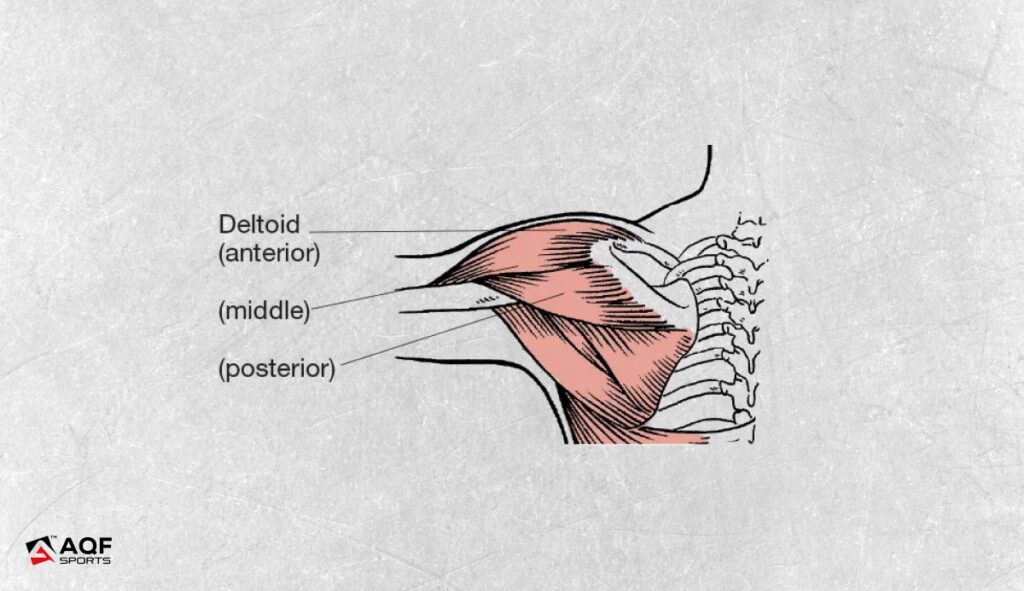
The shoulder joint, also known as the glenohumeral joint, is a ball-and-socket joint [2].
The humerus (upper arm bone) forms the “ball” of the joint, while the glenoid cavity of the scapula (shoulder blade) creates the “socket.”
The rotator cuff, a group of four tendons and muscles, stabilizes the shoulder joint and helps with rotation.The rotator cuff muscles stabilize the humerus within the glenoid cavity to prevent dislocation and fine-tune movements.
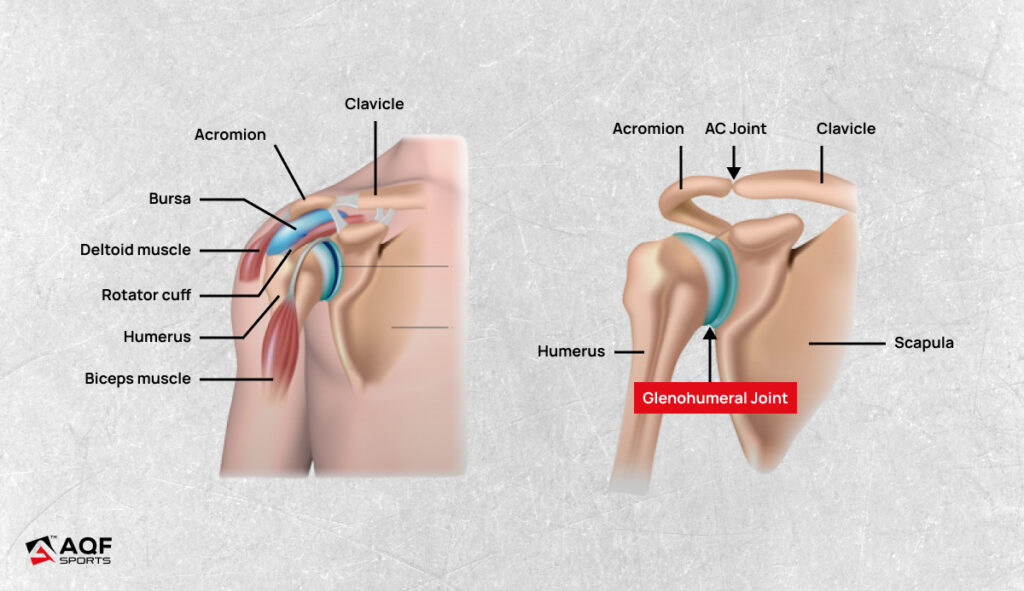
Best Shoulder Exercises [Overall]
Overhead Press:
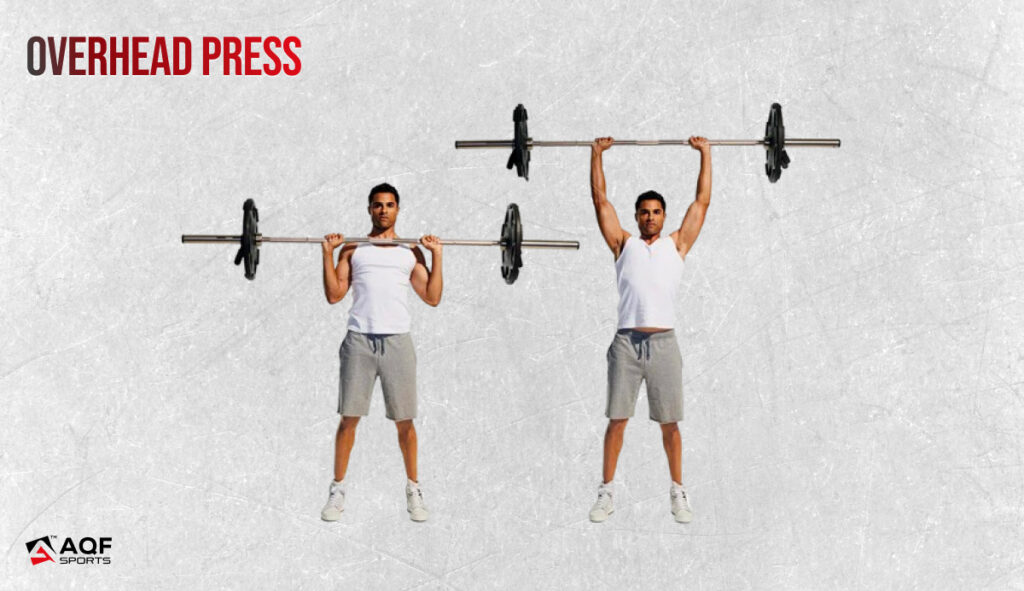
- Sit or stand with a barbell or dumbbells at shoulder height.
- Push the weight directly upward, extending your arms fully.
- Lower the weight back to shoulder level slowly.
- This exercise strengthens the deltoids, essential for punching power and shoulder stability.
Bent-Arm Lateral Raises:
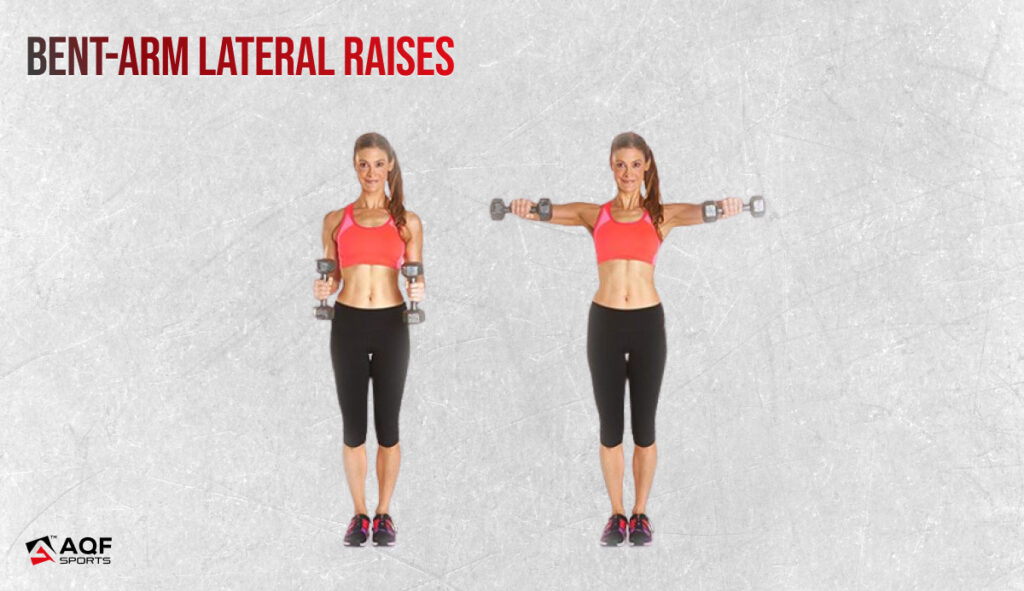
- Muscles Targeted: Lateral (side) deltoids
- How to Do:
- Stand with your feet about hip-width apart, holding a dumbbell in each hand with your palms facing you.
- Bend your elbows, making an L-shape with your arms.
- Lift both your arms out to the sides until they’re at shoulder height, all while keeping your elbows bent.
- At the top, squeeze the middle of your shoulder, which is the lateral deltoid.
- Slowly lower the weights back to where you started.
- Do this exercise for 12-15 reps to target and tone your lateral deltoids.
Front Raises:
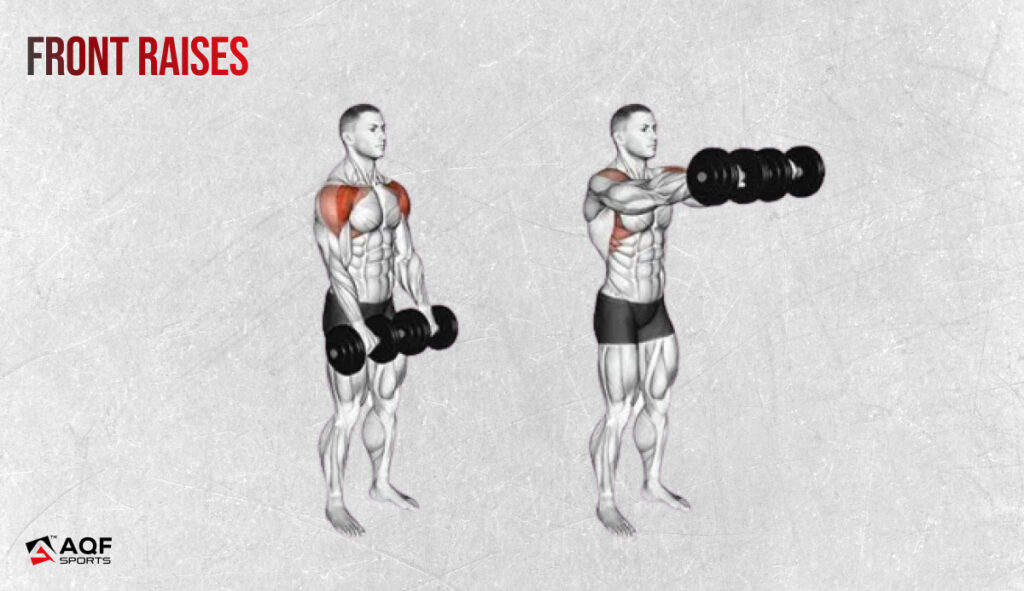
- Muscles Targeted: Front deltoids
- How to Do:
- Stand or sit with a dumbbell in each hand, arms by your sides.
- Keep a slight bend in your elbows and raise your arms in front of you until they are at shoulder level.
- Lower the dumbbells back down slowly and repeat.
Face Pulls:
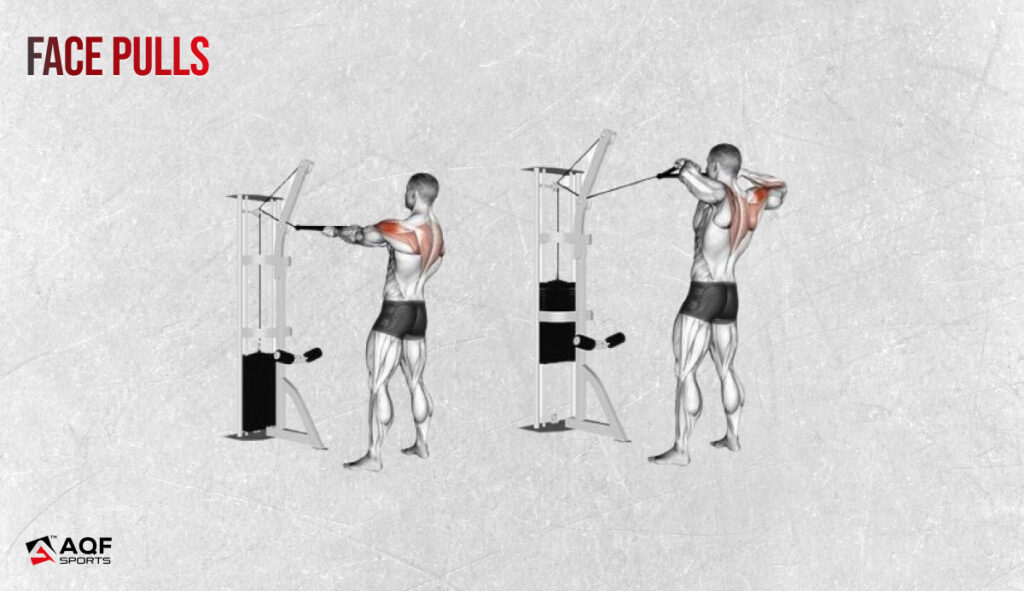
- Muscles Targeted: Rear deltoids, upper traps
- How to Do:
- Attach a rope handle to a cable machine at about head height.
- Stand facing the machine, hold the rope handles with palms facing each other, and step back a bit.
- Pull the rope towards your face, squeezing your shoulder blades together as you do so.
- Lower the rope back and repeat.
Rotator Cuff Exercises:
- Use resistance bands or light dumbbells for internal and external rotations.
- For internal rotations, attach a band to a fixed point, holding the other end with your outside hand and rotate your arm inward.
- For external rotations, the band is anchored on the inside, and you rotate the arm outward.
- Strengthening these muscles helps in shoulder stability and injury prevention.
Shoulder Exercises for Beginners
Dumbbell Shoulder Press:
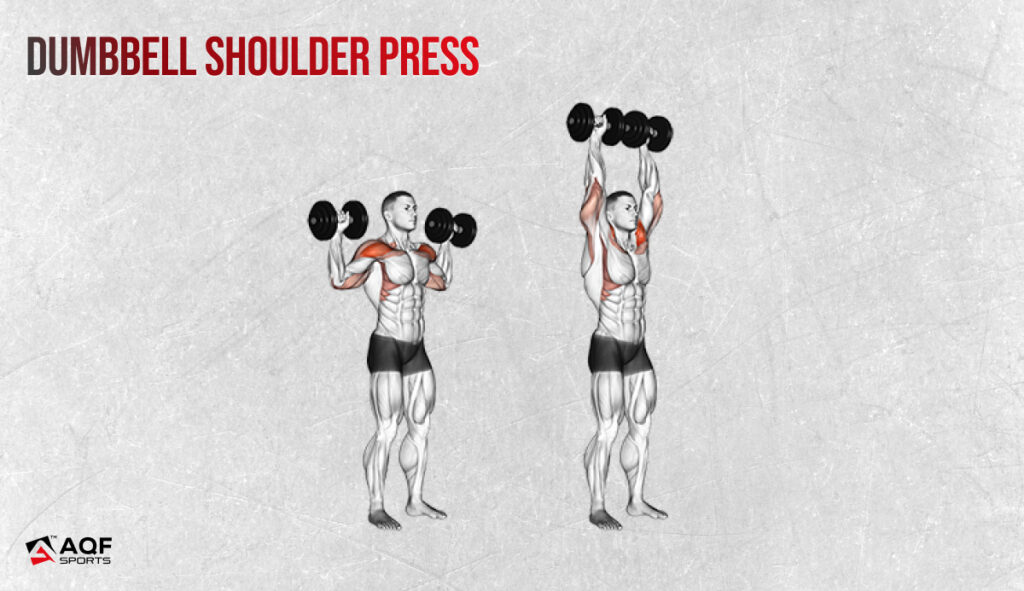
- Muscles Targeted: Deltoid muscles (front, middle, and rear)
- How to Do:
- Sit on a bench with back support, or stand with your feet shoulder-width apart.
- Hold a dumbbell in each hand at shoulder height with your palms facing forward.
- Press the dumbbells overhead until your arms are fully extended.
- Lower the dumbbells back to shoulder height and repeat.
Rear Deltoid Flyes:
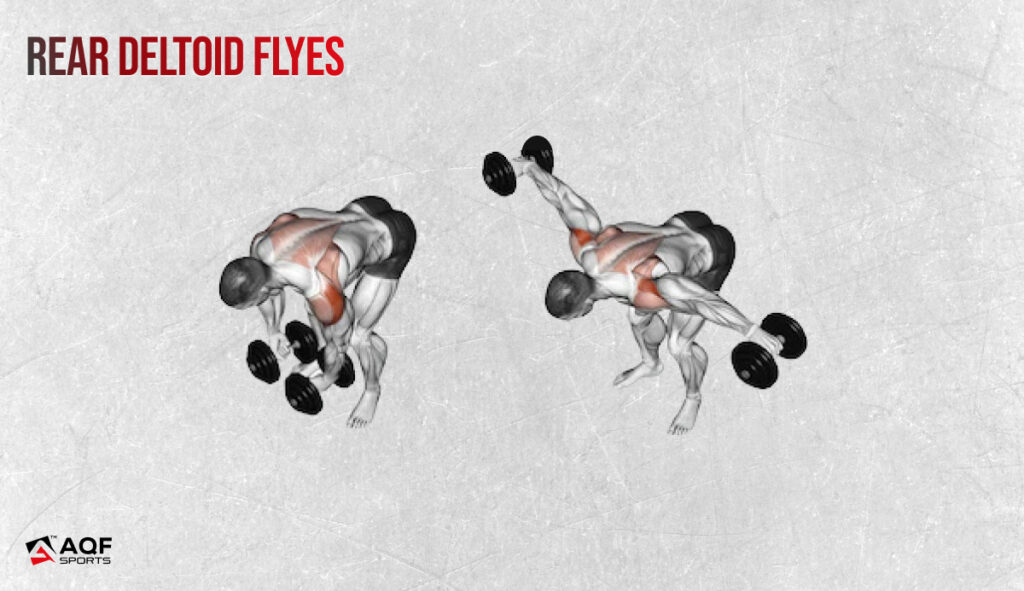
- Muscles Targeted: Rear deltoids
- How to Do:
- Bend at your hips and keep your back flat, holding a dumbbell in each hand.
- Raise your arms to the sides, keeping a slight bend in your elbows.
- Squeeze your shoulder blades together as you lift the dumbbells.
- Lower the dumbbells back down slowly and repeat.
Intermediate Shoulder Exercises
Standing Military Press:
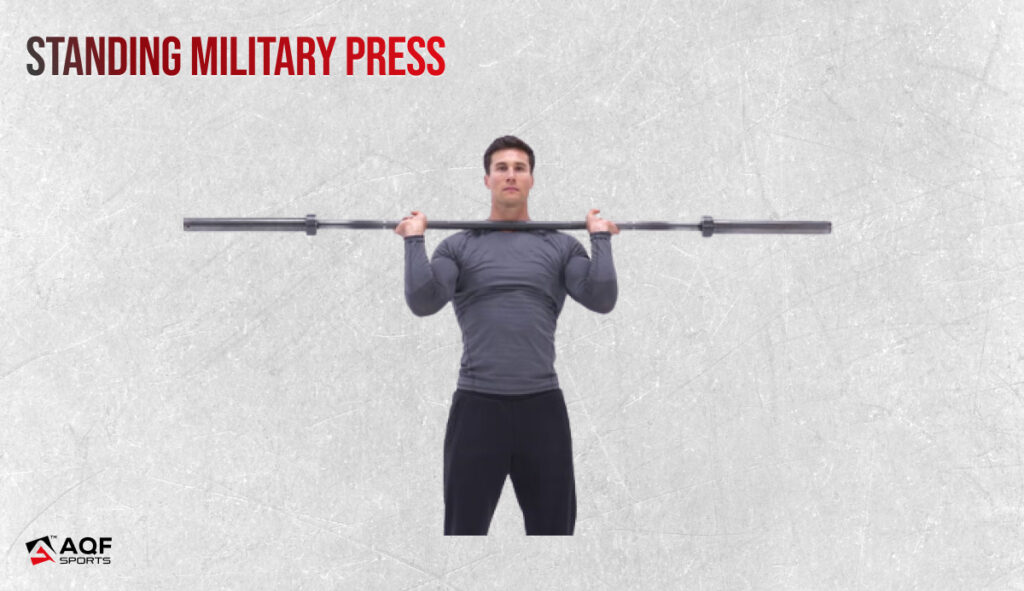
- Muscles Targeted: Deltoid muscles (front, middle, and rear), triceps
- How to Do:
- Stand with your feet hip-width apart.
- Hold a barbell at shoulder height with your palms facing forward.
- Press the barbell overhead until your arms are fully extended.
- Lower the barbell back to shoulder height and repeat.
Arnold Press:
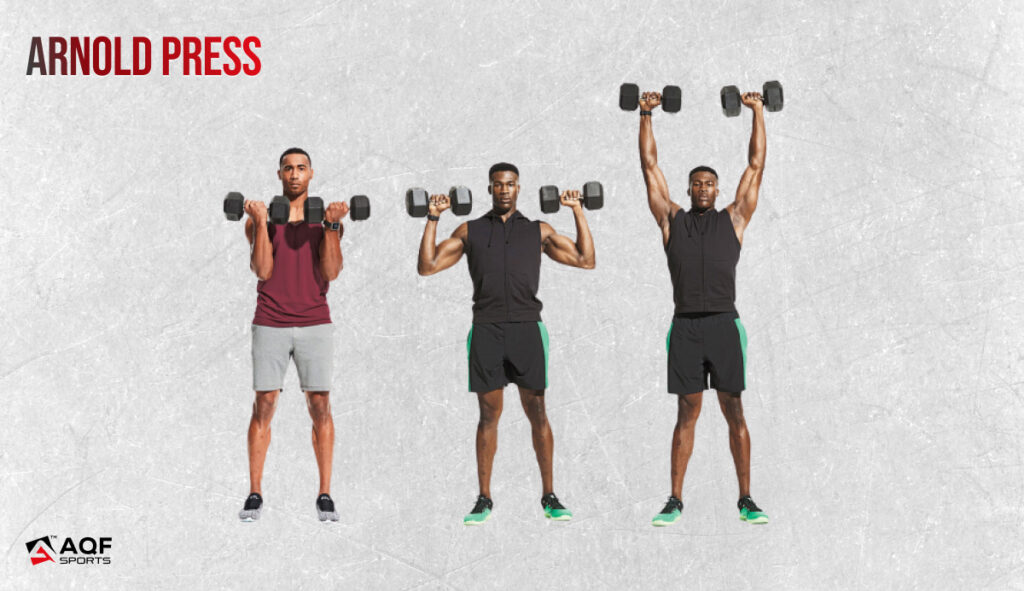
- Muscles Targeted: Deltoid muscles (front, middle, and rear), triceps
- How to Do:
- Sit on a bench with back support, or stand with your feet shoulder-width apart.
- Hold a dumbbell in each hand with your palms facing your body.
- Start with the dumbbells at shoulder height, then rotate your palms outward as you press them overhead.
- Reverse the motion on the way down and repeat.
Upright Rows:
- Muscles Targeted: Lateral deltoids, upper traps
- How to Do:
- Stand with your feet hip-width apart, holding a barbell or an EZ-bar with an overhand grip.
- Keep the barbell close to your body and raise it towards your chin, leading with your elbows.
- Lower the barbell back down and repeat.
Bent Over Lateral Raises:
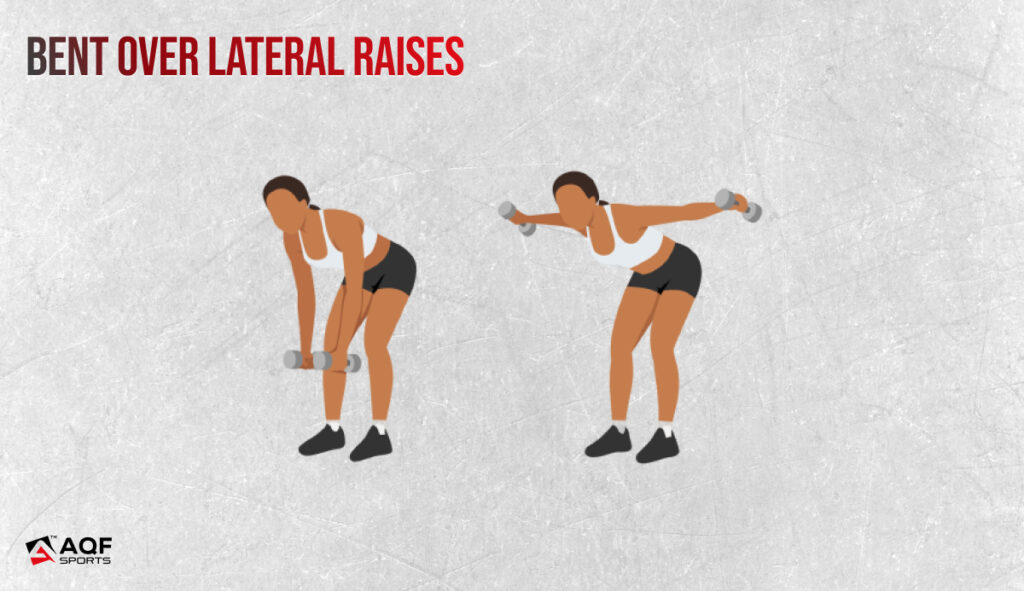
- Muscles Targeted: Rear deltoids, trapezius
- How to Do:
- Bend at your hips to create a 45-degree angle with the floor while holding a dumbbell in each hand.
- Raise your arms to the sides, keeping a slight bend in your elbows.
- Squeeze your shoulder blades together as you lift the dumbbells.
- Lower the dumbbells back down slowly and repeat.
Dumb-Bell Push Press:
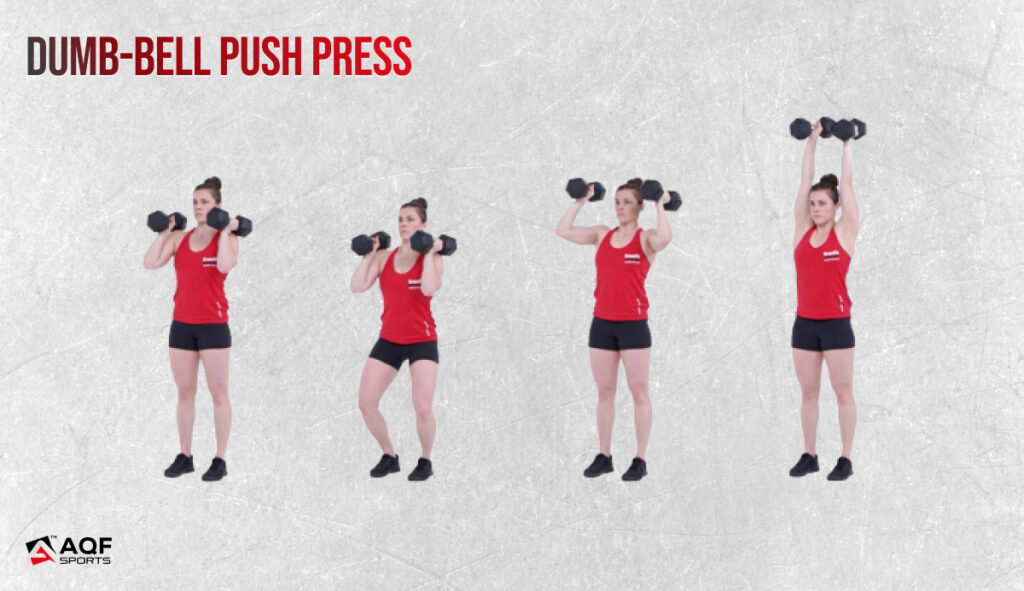
- Muscles Targeted: Deltoid muscles (front, middle, and rear), triceps, and leg muscles
- How to Do:
- Stand with your feet shoulder-width apart, holding a barbell at shoulder height.
- Bend your knees slightly, then explosively straighten them while pushing the barbell overhead.
- Finish with your arms fully extended.
- Lower the barbell back to shoulder height and repeat.
Shoulder Exercises for Pros
Handstand Push-Ups:
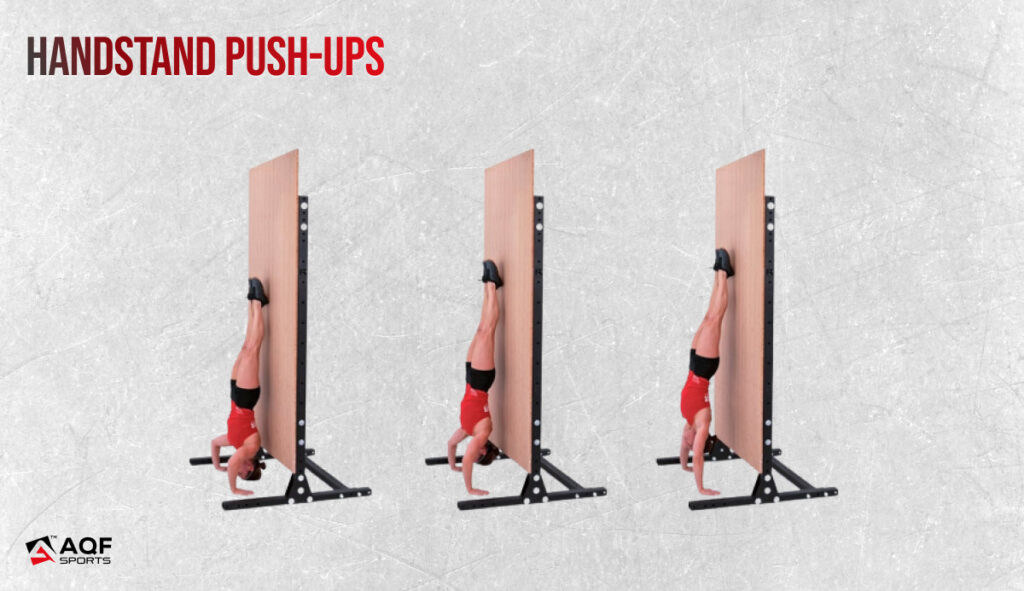
- Muscles Targeted: Deltoid muscles (front, middle, and rear), triceps, upper chest, and core.
- How to Do:
- Start in a handstand position against a wall or with a spotter.
- Lower your body by bending your arms until your head is just above the ground.
- Push your body back up to the handstand position.
- Perform repetitions while maintaining balance.
Barbell Push Press:
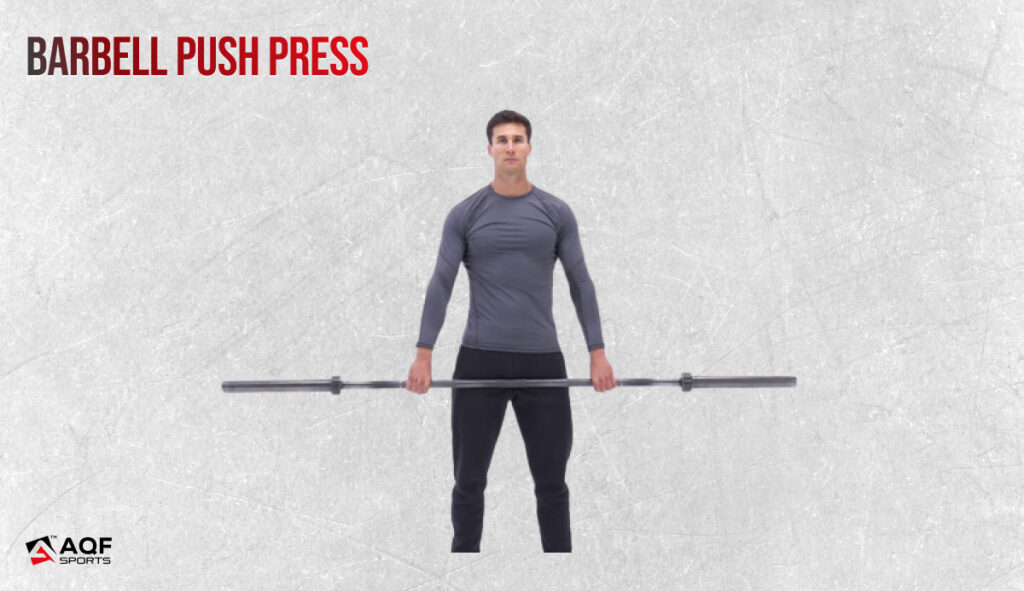
- Muscles Targeted: Deltoid muscles (front, middle, and rear), triceps, and upper chest.
- How to Do:
- Stand with your feet shoulder-width apart, holding a barbell at shoulder height.
- Bend your knees slightly, then explosively straighten them while pushing the barbell overhead.
- Finish with your arms fully extended.
- Lower the barbell back to shoulder height and repeat.
Tip: wear a weightlifting belt for performance boost.
45 Degree Incline Lateral Dumbbell Raises with a Twist:
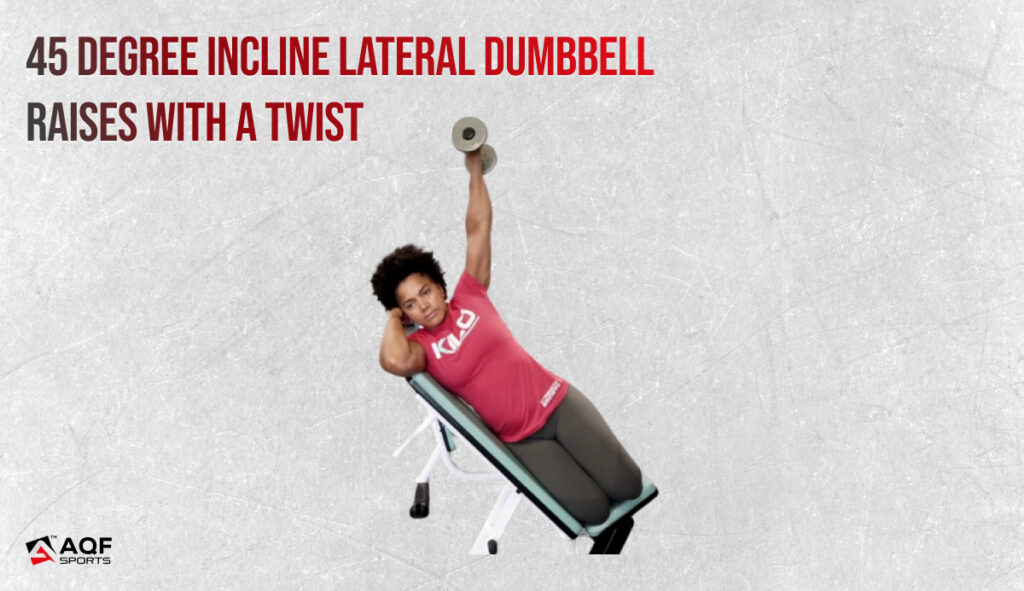
- Muscles Targeted: Lateral deltoids
- How to Do:
- Sit on a bench inclined at a 45-degree angle or use an incline bench if available.
- Hold a single dumbbell in one hand, allowing your arm to hang down naturally by your side.
- Lift the dumbbell out to the side while keeping a slight bend in your elbow.
- Raise the dumbbell to shoulder height, ensuring your palm is facing downward.
- Slowly lower the dumbbell back to the starting position.
Clean and Press:
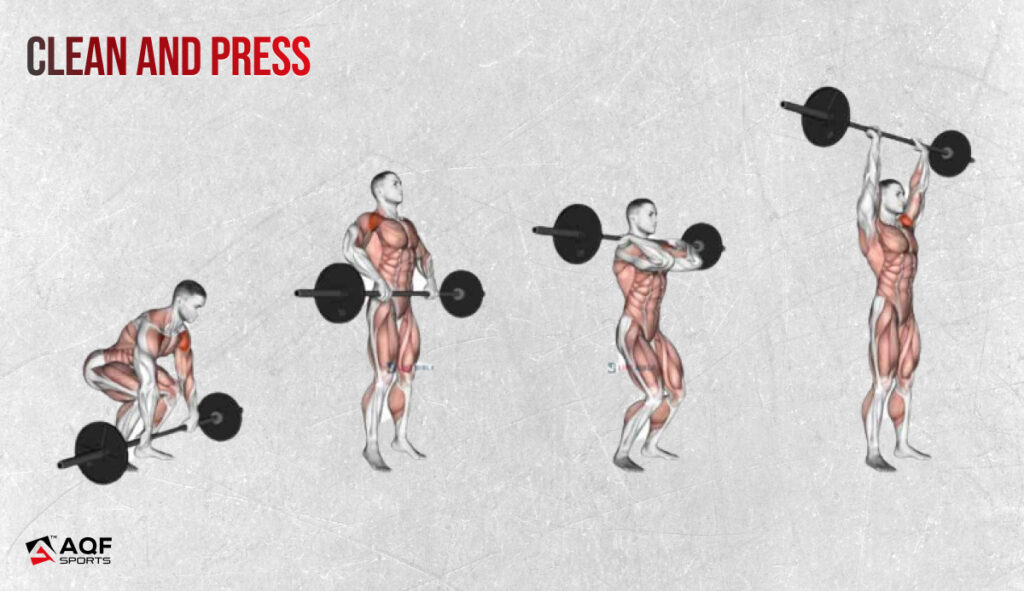
- Muscles Targeted: Deltoid muscles (front, middle, and rear), triceps, upper chest, and various lower body muscles.
- How to Do:
- Begin with a barbell on the floor, squat down, and grab it with an overhand grip.
- Explosively lift the barbell to your shoulders, using your legs, hips, and back.
- From the shoulder position, press the barbell overhead.
- Lower it back to the shoulders and then to the floor. Repeat the full movement.
Tip: wear a weightlifting belt for performance boost.
Shoulder Exercises Workout Plan
| Exercise | Reps | Equipment/Accessories | Estimated Time | Estimated Calories Burned | Expected Results |
| Standing Military Press | 3 sets of 8-10 reps | Barbell or Dumbbells | 15-20 minutes | 100-150 calories | Overall shoulder strength and mass. |
| Lateral Raises | 3 sets of 12-15 reps | Dumbbells | 10-15 minutes | 50-75 calories | Isolation of middle deltoid. |
| Bent Over Lateral Raises | 3 sets of 12-15 reps | Dumbbells | 10-15 minutes | 50-75 calories | Isolation of rear deltoid. |
| Arnold Press | 3 sets of 8-10 reps | Dumbbells | 15-20 minutes | 100-150 calories | Comprehensive deltoid development. |
| Face Pulls | 3 sets of 12-15 reps | Cable Machine | 10-15 minutes | 50-75 calories | Rear deltoid and upper trap development. |
Who Can Do Shoulder Exercises?
A study showed that shoulder stability exercises can enhance shoulder function, especially in middle-aged women [1].
Shoulder exercises are suitable for a broad spectrum of individuals, including:
- Fitness Enthusiasts: Those looking to improve overall strength, aesthetics, and functional movement can benefit from shoulder workouts.
- Athletes: Shoulder exercises are essential for athletes in sports that involve throwing, hitting, or lifting, as strong shoulders can enhance performance and reduce injury risk.
- Office Workers: People spending long hours at a desk can alleviate posture-related discomfort and potential injury with targeted shoulder exercises.
- Seniors: Shoulder exercises can help maintain mobility and reduce the risk of falls and injuries associated with ageing.
How Shoulder Exercises Shape and Tone Your Body?
- Deltoid Development: Shoulder exercises target the anterior, lateral, and posterior deltoid muscles, creating a well-rounded shoulder appearance.
- Back and Traps: Many shoulder exercises engage the upper back and trapezius muscles, leading to improved upper body aesthetics.
- Posture Improvement: Strong shoulder muscles support better posture, reducing the appearance of rounded shoulders.
- Enhanced Waist Appearance: Well-developed shoulders create the illusion of a narrower waistline.
Expected Results:
With consistent shoulder exercises, you can expect:
- Increased shoulder strength and stability.
- Enhanced shoulder definition and shape.
- Improved upper body aesthetics and posture.
- Reduced risk of shoulder injuries.
- A broader, more toned upper body appearance.
What happens if you don’t follow proper form in Shoulder exercises?
The acromion process, a part of the scapula, forms the roof of the shoulder joint and can impinge on structures beneath it if not properly aligned.
Shoulder Impingement:
Shoulder impingement syndrome [4] occurs when the acromion process, which forms the roof of the shoulder joint, pinches or “impinges” on the structures beneath it.
This usually includes the rotator cuff tendons and the bursa, a fluid-filled sac that provides cushioning. Shoulder impingement primarily occurs due to poor form along with several other factors like:
- Inadequate Scapular Control:
Poor scapular (shoulder blade) stability can lead to an improper alignment of the acromion, causing it to press against the rotator cuff tendons during movement.
- Overarching Your Back:
Hyperextending or arching the back during exercises can lead to a forward tilt of the acromion, increasing the risk of impingement.
- Lack of Shoulder Blade Retraction:
Failure to retract the shoulder blades can result in an unnatural and elevated position of the acromion, leading to impingement.
Consequences of Shoulder Impingement:
Shoulder impingement can cause discomfort and potentially serious shoulder injuries, including:
- Rotator Cuff Tendinitis: Inflammation of the rotator cuff tendons due to repeated impingement, resulting in pain and reduced range of motion.
- Bursitis: Inflammation of the bursa due to chronic impingement, leading to pain and discomfort.
- Rotator Cuff Tears: Prolonged impingement can lead to tears in the rotator cuff tendons, causing significant pain and reduced shoulder function.
- Limited Range of Motion: Over time, impingement can reduce the flexibility and mobility of the shoulder joint.
Tips to Prevent Shoulder Impingement during Shoulder Exercises:
To prevent shoulder impingement during exercises, it’s crucial to”
- maintain proper form and posture.
- focus on scapular control.
- avoid excessive arching of the back.
- Lift appropriate weights.
- gradually progress workout resistance.
The Bottomline
Shoulder exercises improve shoulder strength and stability while shaping your upper body. These exercises promote better posture and improve your range of motion. To make the most of your shoulder workouts, warm up beforehand, maintain proper form, gradually increase weights, prioritize controlled movements and shoulder stability. Enjoy the workout!
Explore More topics
- Bro Split – The Ultimate Guide to 5 Day Bro Split Routine
- Chin Ups vs Pull Ups: Clash of the Titans
- 11 Weighted Squats Variations You Need to Add to Your Workout Routine
References:
[1 ]Shoulder Exercises for Delts Study – AceFitness
[2] Deltoid Muscles and Shoulder Anatomy – ClevelandClinic
[3] Shoulder Stability Exercises for Women
[4] Shoulder Inpingement Syndrome – CedarsSinai






